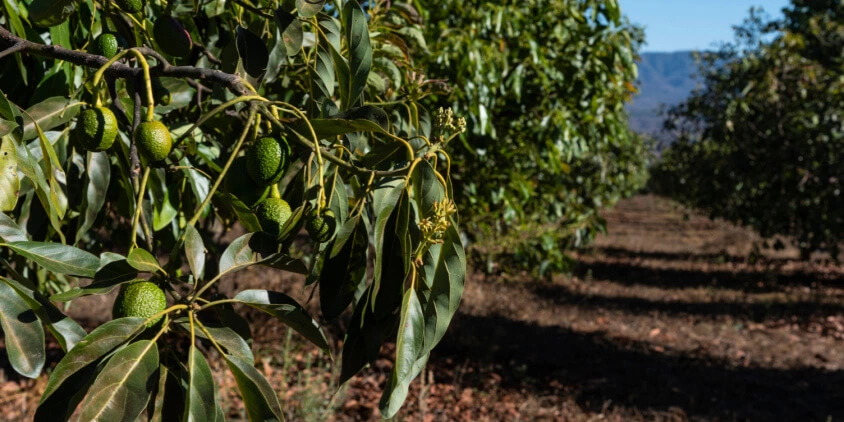
Avocado Farming: Planting And Nurturing For Good Fruit
Avocado farming has witnessed a surge in popularity lately due to the growing global demand for this nutritious fruit. However, just like any other agricultural practice, it’s important to prioritize sustainability to make sure that avocado cultivation remains viable in the long run. Precision agriculture platforms can greatly increase farming productivity without harming the environment. By using data-driven decision-making, managing water and nutrients effectively, and adopting eco-friendly pest and disease control methods, we can make farming avocados more sustainable and economically viable.
Avocado Trees Growing Conditions
Farming avocados requires warm, subhumid environments, such as those found in the tropics and the Mediterranean, where temperatures are consistently high throughout the year.
Although the original avocado-growing zones were Mexico and Central America, the fruit is currently cultivated in many other parts of the world. The most popular varieties thrive in USDA hardiness zones 9 through 11. However, with proper precautions, farming is also possible in Zone 8.
Just a reminder that different varieties have their specific growing and farming requirements. Plant the best-suited variety for your land after carefully considering any environmental issues and potential growth constraints.
Temperature And Sunlight
Most modern avocado varieties prefer warm growing climates and can withstand temperatures as low as 25°F (-4°C). However, both low temperatures and sharp temperature swings seriously restrict the farming of this warm-loving tropical plant. Also, avocado trees, especially young ones, are particularly vulnerable to the stresses of temperatures above 104°F (40°C).
Avocado plants thrive in soil temperatures between 68 and 77°F (20 and 25°C), whereas temperatures below 50°F (10°C) and above 86°F (30°C) significantly impede root growth. To bloom, these trees require a minimum of four weeks of cool weather in the fall and winter. However, temperatures below 50°F (10°C) may stunt blossoming.
Last but not least… How much sunlight do avocado trees need? Most cultivars need between six and eight hours of sunlight per day. Healthy growth and fruit production rely on photosynthesis, which requires regular exposure to sunlight.
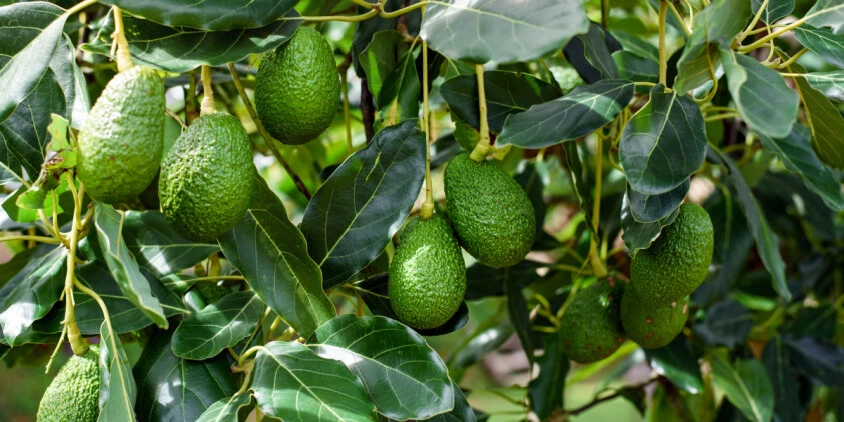
Water And Humidity
The avocado tree is known for its high water consumption. The actual amount of water required for fruitful avocados farming will vary based on factors such as climate, soil type, and tree age. A mature tree requires between 40 and 50 inches (1,000 and 1,300 millimeters) of rain every year, on average .
A favorable humidity level for farming avocado trees is between 60 and 80 percent. Farming is still doable in 40% humidity or less, provided other growing conditions are acceptable, but there is a risk of water stress, increased susceptibility to pests, and flower and fruit drop.
However, too much humidity can lead to the spread of fungal diseases. Therefore, the ideal conditions for farming will include just the right amount of humidity and air circulation. Maintaining a balanced ecosystem for avocado farming requires attention to details like tree spacing, pruning for better airflow, and avoiding waterlogging.
Soil And Nutrients
Although avocado farming is possible in different types of soil, these plants cannot survive in waterlogged environments. They also have a low tolerance for soil salinization. The ideal pH for growing avocados is between 5 and 7. Avocado farming will bring the best results in somewhat acidic soils (pH 6-7), but it’s also feasible in alkaline soils if they drain well.
Successful avocado farming calls for a lot of organic matter, which keeps the soil moist and supplies the plant with the required minerals, including nitrogen, phosphorus, and potassium. Poor soils can benefit from the addition of aged manure or compost. Organic matter added to compacted soil reduces the negative effects of overwatering by improving root growth and oxygenation.
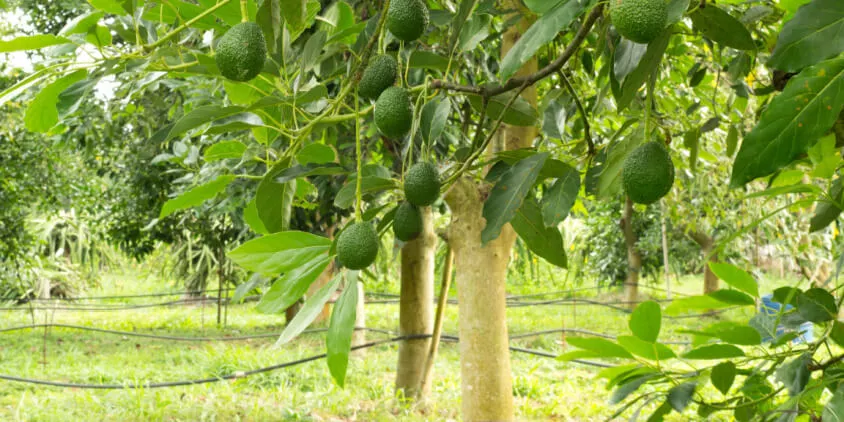
How To Plant Avocado Trees
Planting the trees properly is the first step to successful avocado farming. By preparing the farming site adequately and following appropriate planting techniques, you can give your trees the best chance of establishing strong roots and vigorous growth.
Preparing The Soil For Planting
Before planting, it is essential to prepare the soil for avocado tree. Get rid of the weeds and take a soil sample for analysis to see its composition and nutrient content. Adding organic matter like compost or well-rotted manure to the soil around the tree based on the results of soil testing helps enhance the soil’s structure and nutrient content, creating a more favorable environment for the tree’s roots.
To improve drainage, plant the tree on a mound. This is especially important in farming areas with heavy clay soil. Form a mound that is 3 to 5 feet (0.9–1.5 meters) in diameter and 1 to 2 feet (0.3–0.6 meters) in height.
EOSDA Crop Monitoring
Performing fields analytics based on relevant satellite data to ensure effective decision-making!
Planting Avocado Trees
The best time to plant avocado trees is in the spring. This gives the tree plenty of time to establish roots before the onset of winter weather. Besides, immature trees don’t absorb water well, so they are vulnerable to sun damage if planted in the summer.
The avocado tree’s delicate root system should be treated with care while planting. Make sure the hole for planting a tree is wider than its roots. As for hole depth, it is recommended to be equal to the root ball height. Planting a tree too deeply or too shallowly can limit the root system’s access to water and nutrients and cause the tree to wither.
If you want your trees to reach their full growth potential, you’ll need a large farming area. Make at least 30 feet (9 meters) of avocado planting spacing. Plus, don’t forget about the planting distance of avocado trees from any buildings and constructions: no closer than 13 feet (4 meters).
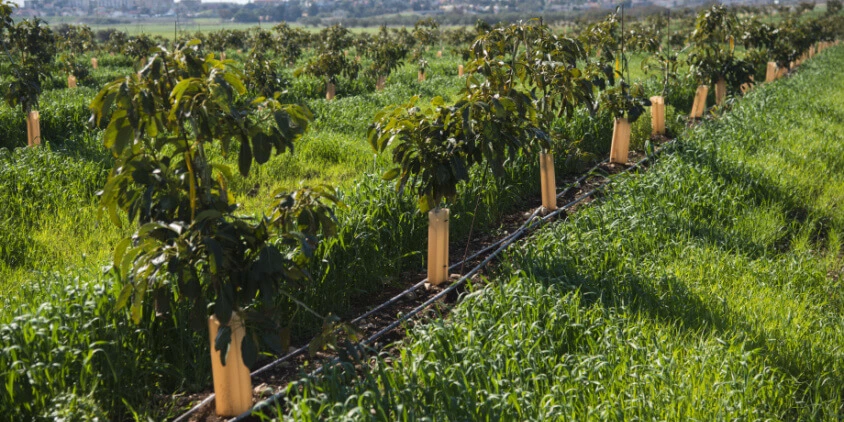
Proper Care and Maintenance In Avocado Farming
Avocado trees need regular maintenance to stay healthy and productive. The specifics of farming practices may vary depending on your location, climate, and plant variety. Consulting with local agricultural extension services and precision farming platforms can provide valuable guidance tailored to your specific situation.
Watering
If you strive for farming success, water young trees 2-3 times a week. Once the plant’s roots have grown down into the soil for about a year, weekly watering will be sufficient, reducing overall avocado farming’s water usage. Before each watering, wait until the soil has dried out a little.
Mature avocados’ water use is about 2 inches (50 mm) per week. Naturally, seedlings will require far less water. According to the traditional method of measuring soil moisture, it is properly moistened if your handprint remains visible after squeezing the earth around the roots.
However, if you’re after greater precision and command, you can use remote sensing data and modern farming technologies to monitor the moisture levels of the soil around your plants. The smart agriculture platform provides you with current and historical (since 2002) root-zone and surface soil moisture data. Tracking the moisture levels will allow you to water your plants at just the right times and amounts.

As temperatures and sunshine levels change, keep the avocado’s high water consumption in mind and adjust your watering schedule accordingly. If it doesn’t rain enough, a fine-tuned avocado irrigation system has to ensure that the trees get the water they need to grow.
Using the Historical Weather function in EOSDA Crop Monitoring, you can determine if your site has a favorable climate for avocado farming and plan effective irrigation and drainage systems. Additionally, with the help of the Weather Forecast feature, you can protect your crop from water stress by taking proactive farming measures like watering and shading.
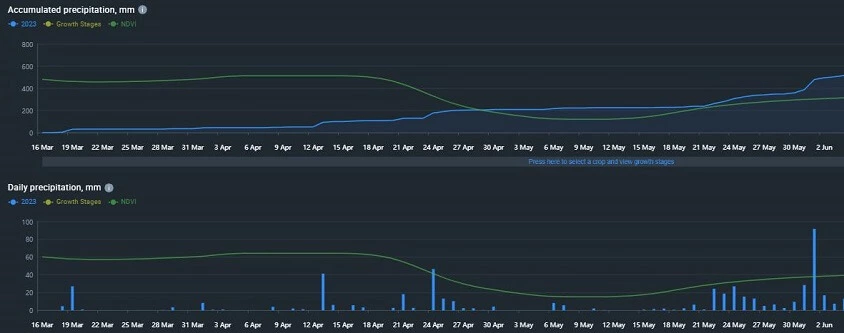

Fertilizing
Mature avocados benefit from nitrogen fertilization. Nitrogen is crucial for avocado farming because it promotes leaf growth, fruit production, and the vitality of the tree as a whole.
| Year | Application rate per tree |
|---|---|
| 1 | 1 tbsp (15 ml) nitrogen fertilizer 3 times a year |
| 2 | 0.25 lb (0.11 kg) of actual nitrogen |
| 3 | 0.5 lb (0.23 kg) of actual nitrogen |
| 4 | 0.75 lb (0.34 kg) of actual nitrogen |
| Starting from 5 | 1 lb (0.45 kg) of actual nitrogen per year |
The soil typically provides an adequate supply of most other nutrients for avocado farming. But sometimes plants lack vital micronutrients like zinc or iron. Foliar feeding with a liquid chelated micronutrient solution can be used to address these deficiencies. For high-yielding avocado farming, it’s also a good idea to amend the soil with sulfated forms of micronutrients like zinc and iron sulfates.
Soils in large farming areas usually have varying amounts of nutrients (e.g., nitrogen). This can lead to differences in farming productivity and yields. The vegetation map of your orchard, generated by EOSDA Crop Monitoring’s proven algorithms, can direct variable-rate nitrogen applications.
In farming areas with low vegetation, it’s common to find nitrogen deficiency. The vegetation map of your field can help you pinpoint problem spots, and a quick soil test will validate your suspicions. Thus, you can ensure that you’re fertilizing avocado trees with the right amount of nitrogen in each zone and increase your farming productivity. You can add more nitrogen to zones with sparse vegetation while reducing it in high-productive areas where the soil’s nitrogen level is already sufficient for farming.

Shaping And Pruning
There’s a proven practice in avocado farming to shape the trees while they are still young. To foster lateral growth and achieve the ideal shape, pinch the tree’s terminal shoots beginning in its second growing season. Not training upright-growing varieties as young trees increases the difficulty of collecting their fruit and adds to the time for farming operations.
Pruning mature avocado trees is a necessary farming activity for keeping trees tidy and allowing enough light and air circulation. You may prune avocado trees lightly throughout the year. Get rid of the dangling branches to make the tree more accessible for farming purposes, and thin out the overgrown canopy so it lets more light and air through. To keep the tree on the compact side, prune the tips to no more than a third of each branch’s length.
Pest And Disease Control
Thrips, mites, borers, caterpillars, and lace bugs are among the few pests that can damage the orchard. As for diseases, avocado farming is in jeopardy due to Phytophthora Root Rot, the most prevalent and severe avocado pathogen. Anthracnose is also a serious threat to farming since it reduces fruit quality and leads to significant losses, particularly after harvest. To protect your farming land from pests or diseases, always be on the lookout for the first warning signs and react quickly.
Processing satellite imagery using a number of vegetation indices allows for disease and pest monitoring in your orchards. With Split View, you can visually compare the state of your crop on two different days, locate avocado farming areas with atypical vegetation (perhaps due to the development of tree disease and insect invasion), and plan your next steps. There are supplementary indices that are more pertinent at certain times during a tree’s growth cycle than the standard NDVI. For instance, the NDRE index provides a more comprehensive study of plants with a dense canopy, hence, it is often used to evaluate vegetation in the later stages of plant growth.
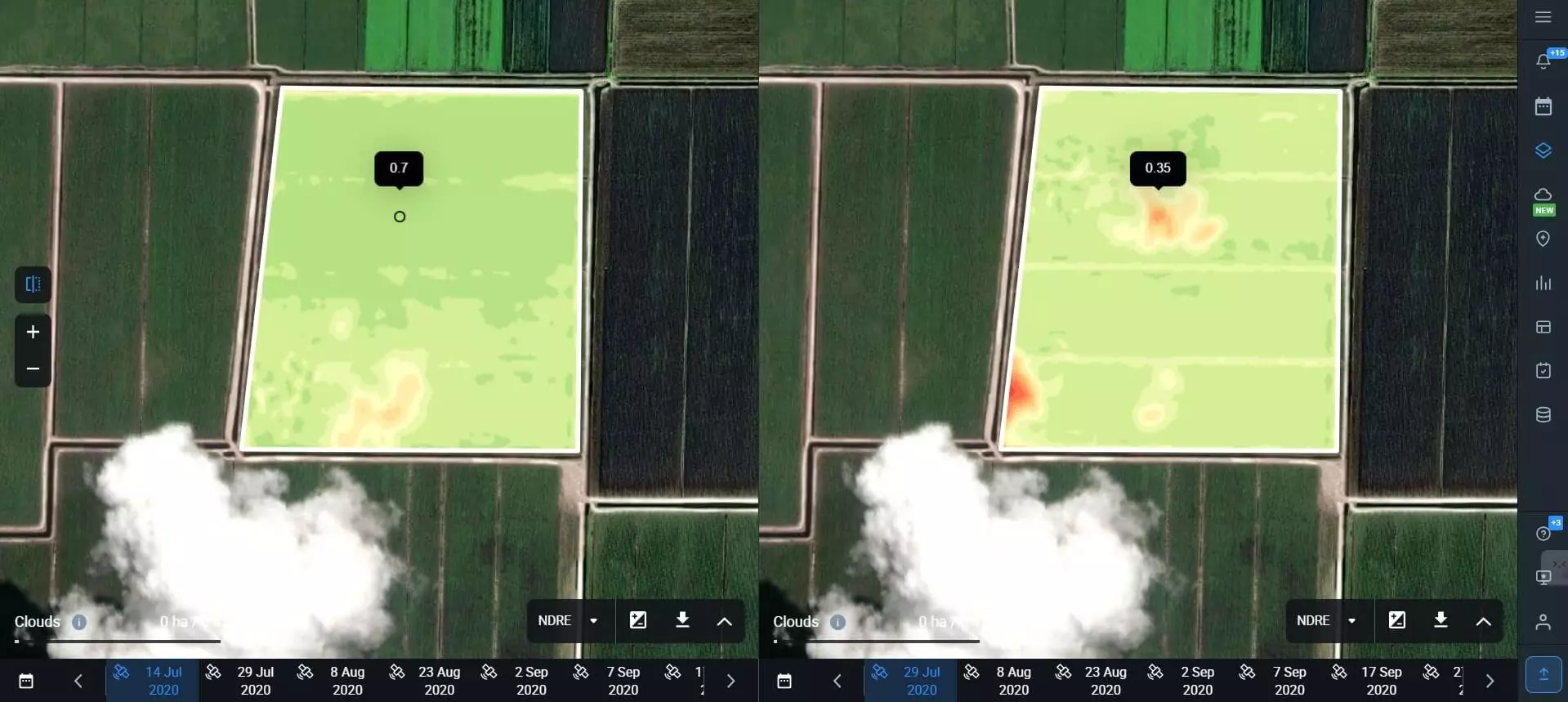
Heat Stress Prevention and Control
Extreme heat can cause serious harm to avocado farming. Near the end of summer, when the trees bloom and produce fruit, heat waves and hot winds bring about the biggest problems with avocado trees. Necrosis of flowers and fruit drop in avocados under heat stress in plants can lead to serious yield losses.
Mature trees rarely experience sunburn. However, you should be aware of how to protect young avocado trees from sunburn while they grow. There are common farming practices to cover young trees with a shade net, paint trunks white, and intersperse overstory rows within the rows of avocados to shield them from the sun’s harmful rays.
Weather risk notifications from EOSDA Crop Monitoring can help you prepare for the probable heat stress on plants. Setting threshold values allows you to be notified before indicators surpass their safe limits for farming. You will get a warning email if there is any danger. With this heads-up, you may take precautions to prevent sunscald and other heat-related damage to your plants.
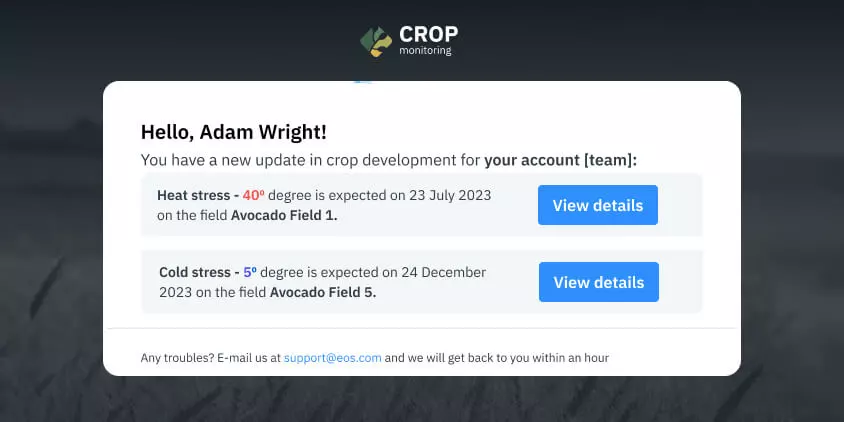
How Long Does It Take For An Avocado Tree To Grow?
Avocados are known for their slow growth compared to many other fruit trees. The time it takes for a tree to reach maturity can vary depending on the variety, growing conditions, and avocado cultivation techniques. When you first start farming, keep in mind that it usually takes between three and five years for a tree planted from a sapling to start producing fruit, but it might take longer.
Some avocado varieties are known to bear fruit earlier. For example, Hass and Fuerte varieties are favored for their relatively early fruiting, often beginning ripening within three to four years under ideal farming conditions.
Although an avocado tree may begin bearing fruit anywhere from 3 to 5 years after planting a sapling, it may take much longer to achieve its full potential for commercial farming purposes. Trees typically reach their productivity peak between the ages of 10 and 20. You can get fruit from a tree for decades, which makes avocado farming a long-lived and rewarding investment.
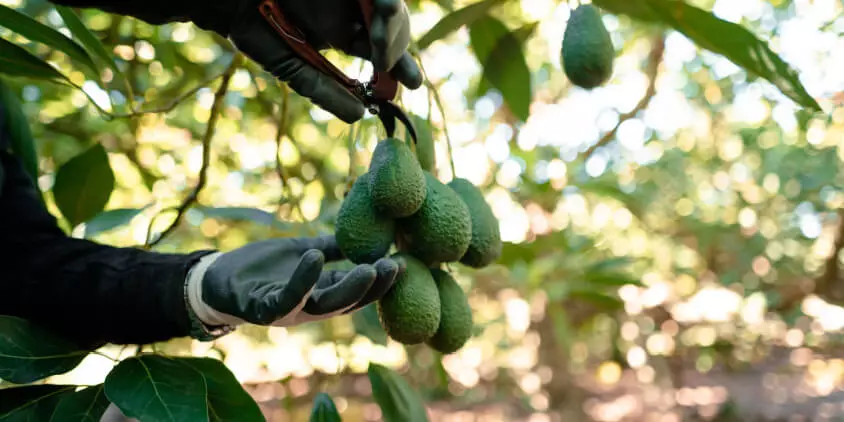
How To Harvest And Store Avocado Fruits
When a fruit has fully changed color, it is ripe and ready to be picked. You’ll know that green kinds are ripe when their skin’s brightness fades and takes on a yellowish hue. Dark purple or nearly black cultivars darken even further as they ripen. To make sure that avocados are ready for harvesting, select one with a short stem and simply leave it on the counter for a couple of days. Watch for the stem not to shrivel or darken, indicating that the fruit is ripe and it’s time to harvest avocado.
Rather than damaging the branch by yanking the fruit off, farmworkers should clip or cut it off with a bit of stem attached. Using farming shears and pruners instead of bare hands makes gathering fruit much easier. To avoid damaging the fruit’s surface, wearing gloves is required.
It typically takes three to eight days for a freshly picked avocado to soften, depending on the temperature. Refrigeration slows the softening process, which occurs at room temperature. You can store fruits for a long time — around several weeks — if you keep them at or slightly above 42°F (5°C).
Is Avocado Farming Sustainable?
Although there are no specific avocado-growing regions now, Central and South America continue to provide the vast bulk of the world’s fruit supply. However, farming did not lead to sustainability in these countries.
In response to the increasing demand for avocados around the world, we see a rise in plantation-style farming, where the fruit is grown in monoculture with extensive amounts of synthetic fertilizers and aggressive agricultural practices that degrade lands . Another avocado farming problem is deforestation: local farmers clear more land to make space for their plantations, which speeds up global warming and reduces biodiversity.
Even though avocado is promoted as a healthy and sustainable fruit, avocado farming negatively impacts the ecosystem. Meanwhile, precision farming technologies have made it possible to manage agricultural inputs more efficiently and lessen the ecological footprint of avocado farming. To ensure long-term environmental viability, growers must also adopt more sustainable farming practices:
- minimize deforestation to clear lands for farming;
- eliminate water wastage by using automated drip irrigation;
- apply eco-friendly integrated pest management practices;
- include biodiverse farming practices, such as beekeeping, in your routine.
These and other sustainable practices not only benefit the environment but also enhance the quality and safety of the fruit, promote consumer trust, and secure the avocado farming industry’s future success.
About the author:
Vasyl Cherlinka is a Doctor of Biosciences specializing in pedology (soil science), with 30 years of experience in the field. He attended the engineering college in Ukraine and received his degree in agrochemistry, agronomy and soil science in the Chernivtsi National University. Since 2018, Dr. Cherlinka has been advising EOSDA on problems in soil science, agronomy, and agrochemistry.
Recent articles

Analyze 2025 & Plan Your Best Year Yet: LandViewer Christmas Offer
It’s the most wonderful time of the year! The Christmas holidays are here, and so is your chance to analyze 2025 and plan a prosperous 2026 with more affordable Pro plans in LandViewer.

EOSDA Models Climate Change Impact On Sugarcane Yields
EOSDA modeled future temperature, rainfall, and other climate impacts on Veracruz sugarcane. The results help growers plan long-term adaptation strategies, including timing, varieties, and irrigation.

EOSDA LandViewer Black Friday Sale: Exclusive Offers & Giveaway
This Black Friday, LandViewer offers new users the chance to save on monthly plans, get extra months with yearly subscriptions, and participate in a free annual plan giveaway.